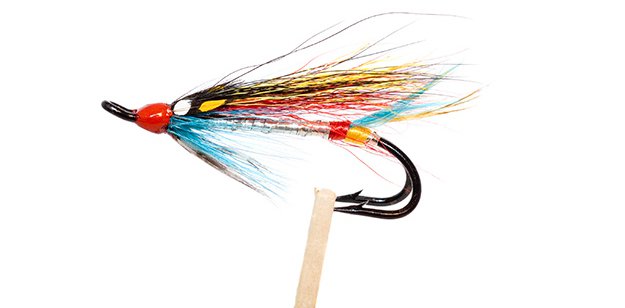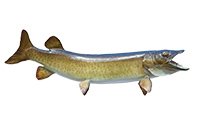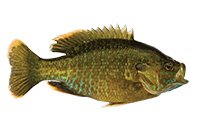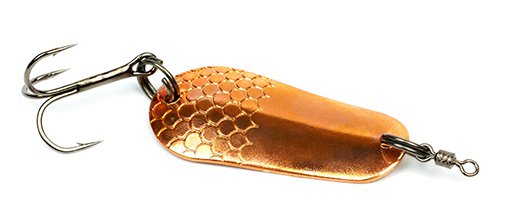
Are you looking for an outdoor activity that’s fun for the whole family? Get hooked on fishing! Whether you’re an experienced angler or a first-time fisherman, there’s plenty of fish for everyone in Berks.
The Rules
There are a few regulations in Pennsylvania to be aware of before casting your line. A fishing license is required for anyone over the age of 16. Licenses cost $22.70 and are valid through Dec. 31. They can be purchased at many locations throughout the county as well as online at fishandboat.com. An additional permit for trout and salmon fishing is also required.
Fortunately for avid anglers, the season in most waters is year-round. A few of the more regulated species, such as trout and bass, have opening days to allow for stocking and population control. You can get opening day info for all gamefish in the 2016 Fishing Regulations. These regulations also outline waterway-specific rules including catch and release, size, creel limit and equipment restrictions. You can pick up a copy at any local bait and tackle or outdoor shop, or online at fishpa.com.
Where to Drop Your Line
Berks County is known for some of the best fishing in Pennsylvania, and with plenty of lakes and streams to choose from, there is a waterway for everyone. The primary population of fish varies based on water temperature, so if you are fishing for something in particular, you’ll need to choose the right location.
If you’re all about that bass, drop your line in one of the area’s many lakes or reservoirs. Largemouth bass and sunfish prefer warmer temperatures. Muskies and walleye prefer cooler waters, so you might find them in deep lakes or larger rivers. Trout are cold water fish and are primarily stocked in streams. There are 23 stocked streams in Berks, some over multiple stretches, as well as three stocked reservoirs. The Trout Stocking Schedule can be found at fishandboat.com.
Antietam Lake Park, Lower Alsace Township
Blue Marsh Lake, Leesport
Carsonia Lake, Reading
Hopewell and Scott’s Run Lakes at French Creek State Park, Elverson
Kaercher Creek, Hamburg
Schuylkill River, flows from the Poconos to Philadelphia, joined by the Tulpehocken Creek in Reading
Trout Run Reservoir, Boyertown
Tulpehocken Creek, flows from Lebanon County, through Blue Marsh Lake, to the Schuylkill River in Reading

Fly Fishing 101
If you are ready to get out of the boat and to wade into the water, fly fishing could be just the challenge you’re looking for. Instead of casting bait, you cast an intricate setup consisting of a fly line, a leader and a fly that makes the line virtually invisible to the fish. Using a series of different casts, you drift the fly along the surface, but go too fast or too slow, and the fish will catch on!
Many anglers tie their own flies using feathers, fur and synthetic materials to create a pattern that will fool the fish. There are no limits to what you can catch, but trout is the most common quarry. The Tulpehocken Creek is famously successful for trout, and the Schuylkill River is a great place for smallmouth bass.
Ready to give it a try? TCO Fly Shop offers hands-on lessons on the fundamentals, from choosing the correct equipment to casting skills to trout behavior and etymology. Or attend fly swaps and demonstrations with the Berks County Fly Tyers Club.
TCO Fly Shop | 2229 Penn Avenue, West Lawn | 610.678.1899 | tcoflyfishing.com
Berks County Fly Tyers Club | berksfly.org
Fish Finder
Half the fun of fishing is being surprised by what is on the end of your line. While there are many species to be found locally, here is a roundup of the most common catches.

Trout
Three species of trout are common in local waterways. There are wild trout streams with populations of brook trout, as well as stocked trout waters that receive rainbow, brown and brook trout. This fish is actually a member of the salmon family and has one characteristic not common to many species: an adipose fin, a small fin found between the dorsal and caudal fins.

Largemouth Bass
This fish is a member of the sunfish family and is a distinctive green color with a dark bar of black blotches down its side. It is usually found in warmer lakes, while its sportier relative the smallmouth bass can be found in cooler, faster moving waters.

Muskellunge aka “Muskies”
Sportsmen hold this member of the pike family in high esteem because it is a good game fish with a voracious appetite. Muskies have a longer, pointed head and are usually grey-green with light vertical stripes on their backs and spots on their fins.

Catfish
Catfish are a rather distinct family of bewhiskered, scaleless fishes with a spiny ray in the dorsal fin and spines in each pectoral fin. Local anglers are most familiar with the channel and the flathead catfish.

Sunfish
Local members of this family include bluegills (aka sunnies), crappie bass, (aka crappies) and pumpkinseeds, and are important panfish to many fishermen. They have deep, narrow bodies and each has a characteristic color pattern.

Bait Basics
There are endless options to choose from when shopping for fishing equipment. The necessary gear varies based on what you are fishing for, and each approach will have success in different conditions. Get started with these bait basics, but the real fun is in learning what works for you!
Live Bait
Minnows, worms, crayfish, and insects are all productive baits because they allow you to present the exact prey of the fish you are targeting. All fish can be caught on live bait, and it is easy to use, making it great for kids. It can also require less casting; just throw the bait under a bobber and relax until you get a bite.
Soft Baits
There is a wide range of plastic-based baits that come in various shapes, sizes and colors. These baits are soft, flexible, inexpensive and easy to keep on hand. Try these when fishing for largemouth bass and sunfish.
Crankbaits
These are baitfish imitating lures that you cast
out as far as you can and crank back to simulate a baitfish swimming through the water. Try these for largemouth and smallmouth bass.
Spinnerbaits
These lures have metal blades shaped to spin like a propeller when in motion, creating varying degrees of flash and vibration that mimic small fish. Spinners are great for attracting sportfish like muskies, walleye, pike and perch.
Spoons
Aptly named, these metal lures are shaped like the bowl of a spoon and attract fish by reflecting light and moving randomly through the water. Try these for walleye and muskies.
Jigs
Smallmouth bass and sunfish like these heavy, leaded baits decorated with an attractive skirt or trailer.
Are you looking for an outdoor activity that’s fun for the whole family? Get hooked on fishing! Whether you’re an experienced angler or a first-time fisherman, there’s plenty of fish for everyone in Berks.
The Rules
There are a few regulations in Pennsylvania to be aware of before casting your line. A fishing license is required for anyone over the age of 16. Licenses cost $22.70 and are valid through Dec. 31. They can be purchased at many locations throughout the county as well as online at fishandboat.com. An additional permit for trout and salmon fishing is also required.
Fortunately for avid anglers, the season in most waters is year-round. A few of the more regulated species, such as trout and bass, have opening days to allow for stocking and population control. You can get opening day info for all gamefish in the 2016 Fishing Regulations. These regulations also outline waterway-specific rules including catch and release, size, creel limit and equipment restrictions. You can pick up a copy at any local bait and tackle or outdoor shop, or online at fishpa.com.
Where to Drop Your Line
Berks County is known for some of the best fishing in Pennsylvania, and with plenty of lakes and streams to choose from, there is a waterway for everyone. The primary population of fish varies based on water temperature, so if you are fishing for something in particular, you’ll need to choose the right location.
If you’re all about that bass, drop your line in one of the area’s many lakes or reservoirs. Largemouth bass and sunfish prefer warmer temperatures. Muskies and walleye prefer cooler waters, so you might find them in deep lakes or larger rivers. Trout are cold water fish and are primarily stocked in streams. There are 23 stocked streams in Berks, some over multiple stretches, as well as three stocked reservoirs. The Trout Stocking Schedule can be found at fishandboat.com.
Antietam Lake Park, Lower Alsace Township
Blue Marsh Lake, Leesport
Carsonia Lake, Reading
Hopewell and Scott’s Run Lakes at French Creek State Park, Elverson
Kaercher Creek, Hamburg
Schuylkill River, flows from the Poconos to Philadelphia, joined by the Tulpehocken Creek in Reading
Trout Run Reservoir, Boyertown
Tulpehocken Creek, flows from Lebanon County, through Blue Marsh Lake, to the Schuylkill River in Reading

Fly Fishing 101
If you are ready to get out of the boat and to wade into the water, fly fishing could be just the challenge you’re looking for. Instead of casting bait, you cast an intricate setup consisting of a fly line, a leader and a fly that makes the line virtually invisible to the fish. Using a series of different casts, you drift the fly along the surface, but go too fast or too slow, and the fish will catch on!
Many anglers tie their own flies using feathers, fur and synthetic materials to create a pattern that will fool the fish. There are no limits to what you can catch, but trout is the most common quarry. The Tulpehocken Creek is famously successful for trout, and the Schuylkill River is a great place for smallmouth bass.
Ready to give it a try? TCO Fly Shop offers hands-on lessons on the fundamentals, from choosing the correct equipment to casting skills to trout behavior and etymology. Or attend fly swaps and demonstrations with the Berks County Fly Tyers Club.
TCO Fly Shop | 2229 Penn Avenue, West Lawn | 610.678.1899 | tcoflyfishing.com
Berks County Fly Tyers Club | berksfly.org
Fish Finder
Half the fun of fishing is being surprised by what is on the end of your line. While there are many species to be found locally, here is a roundup of the most common catches.

Trout
Three species of trout are common in local waterways. There are wild trout streams with populations of brook trout, as well as stocked trout waters that receive rainbow, brown and brook trout. This fish is actually a member of the salmon family and has one characteristic not common to many species: an adipose fin, a small fin found between the dorsal and caudal fins.

Largemouth Bass
This fish is a member of the sunfish family and is a distinctive green color with a dark bar of black blotches down its side. It is usually found in warmer lakes, while its sportier relative the smallmouth bass can be found in cooler, faster moving waters.

Muskellunge aka “Muskies”
Sportsmen hold this member of the pike family in high esteem because it is a good game fish with a voracious appetite. Muskies have a longer, pointed head and are usually grey-green with light vertical stripes on their backs and spots on their fins.

Catfish
Catfish are a rather distinct family of bewhiskered, scaleless fishes with a spiny ray in the dorsal fin and spines in each pectoral fin. Local anglers are most familiar with the channel and the flathead catfish.

Sunfish
Local members of this family include bluegills (aka sunnies), crappie bass, (aka crappies) and pumpkinseeds, and are important panfish to many fishermen. They have deep, narrow bodies and each has a characteristic color pattern.

Bait Basics
There are endless options to choose from when shopping for fishing equipment. The necessary gear varies based on what you are fishing for, and each approach will have success in different conditions. Get started with these bait basics, but the real fun is in learning what works for you!
Live Bait
Minnows, worms, crayfish, and insects are all productive baits because they allow you to present the exact prey of the fish you are targeting. All fish can be caught on live bait, and it is easy to use, making it great for kids. It can also require less casting; just throw the bait under a bobber and relax until you get a bite.
Soft Baits
There is a wide range of plastic-based baits that come in various shapes, sizes and colors. These baits are soft, flexible, inexpensive and easy to keep on hand. Try these when fishing for largemouth bass and sunfish.
Crankbaits
These are baitfish imitating lures that you cast
out as far as you can and crank back to simulate a baitfish swimming through the water. Try these for largemouth and smallmouth bass.
Spinnerbaits
These lures have metal blades shaped to spin like a propeller when in motion, creating varying degrees of flash and vibration that mimic small fish. Spinners are great for attracting sportfish like muskies, walleye, pike and perch.
Spoons
Aptly named, these metal lures are shaped like the bowl of a spoon and attract fish by reflecting light and moving randomly through the water. Try these for walleye and muskies.
Jigs
Smallmouth bass and sunfish like these heavy, leaded baits decorated with an attractive skirt or trailer.
















